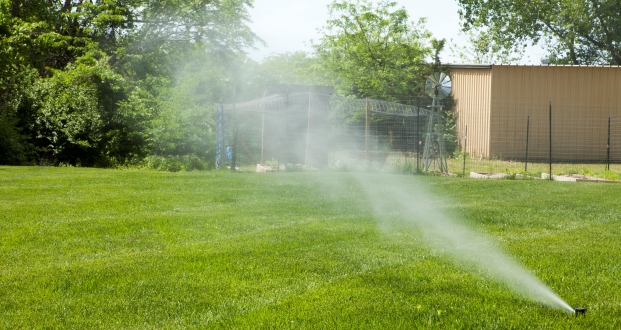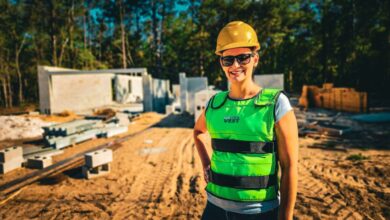Avoid irrigation system damage with these winterization tips
By Tom Glazener and Laura Ory

In areas with prolonged freezing, and even temperate climates, irrigation winterizing can help avoid repair calls when spring rolls around.
Pumps, backflow preventers, pipe, valves and rotors can get damaged if any water sitting in the system freezes and expands. Even controllers and electronic components can be at risk from condensing moisture in enclosures.
But these issues can be typically be avoided by winterizing — removing water from an irrigation system so it doesn’t get damaged when temperatures drop. This can be accomplished with manual or automatic drainage or a blowout method using a high-volume air compressor.
Some winterizing techniques can also pose risks however. As you prepare for winter, here are some points to remember as you get your irrigation systems ready for the cold.
1. Safety first!
Always use eye protection when performing a blowout, and make sure no one is standing near parts of the system while the air compressor is in use.
PVC pipe becomes like shrapnel if it explodes, so avoid applying air pressure to PVC that is not buried, and keep your face and head protected.
2. Allow a path for water to exit the zone.
Remove the “guts” from the last sprinkler heads on large zones to allow more volume out during the blowout process. This makes it easier for air to drive out the water that cannot pass as effectively through nozzles at lower pressures.
3. High volume and low pressure saves components.
When using an air compressor to evacuate water from the system, you want low pressure and high volume — a small air compressor won’t cut it!
Use an air compressor with an airflow rating of 80 to 100 cubic feet per minute (CFM), for mainlines that are two inches or less. (Larger systems will require larger air volumes.)
When operating the air compressor, the lower the pressure the better. Don’t exceed the maximum operating pressure of the heads for each zone, and never exceed 50 psi for polyethylene tubing and 80 psi for PVC pipe.
Why? Irrigation components such as rotors are designed for the resistance that water provides. Once the water evacuates during a blowout, compressible air strikes the impellers and gears; if the pressure is too high, the change in velocity can be almost explosive.
Larger tow-behind compressors often lack the regulators needed to bring pressures down this low, so make sure you have one available, especially if a rental yard compressor is used to ensure your pressure stays within reasonable limits.
4. Use an appropriate connection point.
Whenever possible, avoid blowing air through water meters, flow meters, pumps and backflow preventers. These devices are designed to handle water — high-velocity air can spin and disturb components in ways they were not designed to handle, resulting in repairs, replacements or voided warranties.
For an optimal air hose connection for small to medium size systems, use a quick coupler valve (QCV) downstream from the backflow device, if one exists. If a QCV is not available after the backflow, consider installing one just for this purpose. A quick connect adaptor for a 1-inch air hose plumbed to a key and swivel makes for a clean connection.
Some models of backflow preventers also have a check/relief valve assembly that can be removed and replaced with a blowout fitting to allow for blowout without component damage.
If there are any manual drain valves on the system, make sure they are closed before the blowout and close the backflow isolation valve. Because air-relief valves relieve air, they also need to be removed and capped so air pressure can build in the system during blowout.
5. Keep it cool.
When using an air compressor, air can compress when the flow of water and air is restricted. The more air compresses, the hotter it gets — hot enough to warp and even melt some components!
Keep pressure and temps down by preventing “dead-heads” (no-flow situations) against closed valves by using lower pressure and keeping a flow going at all times.
During the blowout process, gradually open the compressor valve after you energize the first valve. Using a handheld remote or while standing at the controller, cycle through each zone, from the farthest to closest. Keep at least one valve open while compressed air enters the system, and turn off your air compressor before closing the last valve.
Cycle through the zones two or three times, until they run dry (typically 2 to 3 minutes). To avoid overheating the system, run air for no more than about two minutes per pass through each zone, and stop once the zone is dry.
Refer to manufacturer’s recommendations for blowing out and/or draining drip components.
6. Be thorough.
It’s important to know the system, and make sure each component gets drained — a system reference diagram can really help.
After the blowout, drain any riser pipe before and after the backflow device. Many facilities remove above-ground units and store them inside, capping the risers once drained. Refer to the manufacturer’s recommendations for draining or removing your backflow device.
Typically for a pressure vacuum breaker (PVB), double check (DCV) or reduced pressure principle device (RP) you’ll need to open the test cocks a quarter turn and open ball valves 45 degrees for the winter. If these devices must remain pressurized, blankets, heat tape and heated enclosures are available.
For pumps, turn off the power and empty all water out of drain ports. Add any lubrication or other maintenance necessary by referring to manufacturer’s recommendations.
If you’ve manually or automatically drained the system, make sure any sprinklers with check valves have also been pulled up and drained. And be sure to seal off any open points in the system.
Finally, adding silica gel desiccant packs inside any controllers housed outdoors can help prevent condensed water and ice from causing damage. Power can be left on to the transformer, but make sure to choose the “off” or “rain” setting for the controller.
Tom Glazener is employee development and training coordinator, and Laura Ory is social media & digital strategist at Ewing Irrigation and Landscape Supply.
Photo by Jesse Tallman, Ewing Irrigation.
Blowout Quick Tips
- Shut off water to the irrigation system and drain or prepare to blow out the system.
- With the air compressor attached to a proper point of connection, use the controller or a remote to cycle through all the valves to evacuate water.
- Drain the backflow preventer and leave ball valves at a quarter turn. Partially open any isolation gate valves.
- Check any pump on system and evacuate water through drain ports. Tend to lubrication and other maintenance needs.
- Protect controllers from moisture with silica gel desiccant packs.


